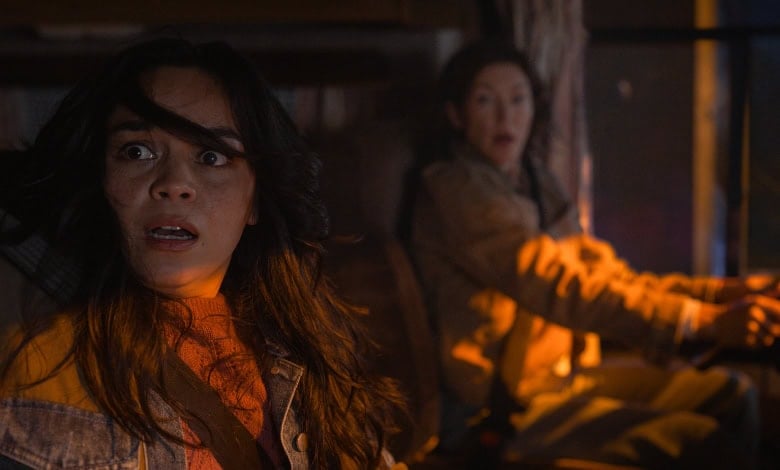
James Wong’s “Final Destination” is now 25-years old, a six-film franchise (so far) and a celebrated horror series that fans have grown up with.
The odd twist is that, whereas most horror franchises have an iconic figure as the central antagonist, Wong’s 2000 film has a concept, an unseen threat, who does all the slashing.
The murders come across less like acts of homicide than someone dying of being a severe klutz.
The plot: a group of high schoolers gather at an airport to catch a red-eye flight. Only one of them, Alex Browning, played by Devon Sawa, seems aware of a feeling of danger in the air. Warning signs come from sounds and moments of de ja vu.
Finally, once Alex and his classmates (which include Seann William Scott and Ali Larter) board the plane, we witness the plane take off and almost immediately burst into flames … which turns out to be a premonition. Alex saw the whole thing as a vision, freaks out and is forced off the plane, along with a cluster of classmates.
The tragedy that suddenly occurs not only proves the premonition to be true but makes the remaining teens slowly realize that they’re in the path of Death’s Design, that the end will be coming for them soon.
The opening sequence, reportedly a pitch for an “X-Files” episode that never materialized, feels like the best of “The Twilight Zone.” More specifically, it feels like a companion piece to a terrific, Kevin Reynolds-directed1985 episode of “Amazing Stories” (1985-1987) called “You Gotta Believe Me.”
That installment featured Charles Durning as an elderly man who walks out of his retirement home over to a nearby airport, where he frantically warns passengers that the plane they’re about to board is doomed.
RELATED: HOW TONY FODD PUMPED LIFE INTO ‘DEAD’ REMAKE
The first act of “Final Destination” makes for a powerful first 30 minutes. The rest of the film is always captivating but so silly. The same goes for the sequels, which all begin with riveting, violent set pieces that work so well, that they carry the rest of the violent slapstick and redundant set pieces of teens dying from a major case of the “oopsies.”
Until the new and wonderful “Final Destination: Bloodlines,” the sixth sequel that deserves its surprise box office success, all of the prior installments suffered from starting strong, then flatlining long before the cast of characters did.
“Final Destination: Bloodlines” is easily the best in the franchise so far, though fans of the series have their favorite spinoff and justly celebrate the single recurring touch – the casting of Tony Todd as a mysterious, all-knowing morgue attendant named Bludworth.
If “Final Destination” fans are revisiting the entire series in preparation for the new film, I have a suggestion for a double feature that extends outside of the series. In fact, a horror film released earlier this year is not only strikingly similar to “Final Destination” but, like its recent sequel, surprises for being so sharp and fully realized.
The superior model is “The Monkey,” Osgood Perkins’ morbid comedy that leans into “Final Destination” territory, but with a more thoughtful meditation on loss and what comes after.
Theo James stars as twin brothers Hal and Bill, who grew up aware of a toy windup monkey that, if activated, could kill an intended victim. How the toy monkey does it is where the “Final Destination” comparison comes in.
The monkey is the evil totem who summons an invisible force that creates “accidents.” Upon inspection, the deaths created by the monkey appear to be random, messy and attributed to human error.
Nothing Theo James has done before prepared me for how strong his work is here. Yet, James is better playing the “good” twin than the other one. Another slight problem is that the third-act confrontation feels inevitable.
However, the concluding moments somehow manage to serve up optimism, wonder and savage gore.
Perkins’ film, a superior follow-up to “Longlegs” (2024) and his best film so far, is hilarious, gross and engrossing. It begins with the premise of Stephen King’s 1980 short story of a windup monkey and childhood toy embodying childhood trauma and provides the possibility of embracing life, even as death is a certainty.
Perkins makes this personal and harsh but also leans into the comic possibilities of the scenario and concludes in a manner more hopeful than expected.
In his first work post-“Longlegs,” Perkins once again demonstrates how vivid and frightening his work can be (there are some big jolts) but the shocks here are often countered by gallows humor.
Perkins avoids the specificity of the period setting, even feeling mid-1980s at times, despite the eventual contemporary period depicted. “The Monkey” never leans into nostalgia or the period signposts but focuses on guilt and grief carried over from childhood.
Then there’s “Final Destination,” with its young cast, about teens who, if they don’t survive Death’s Design, won’t have anything to be nostalgic about.
